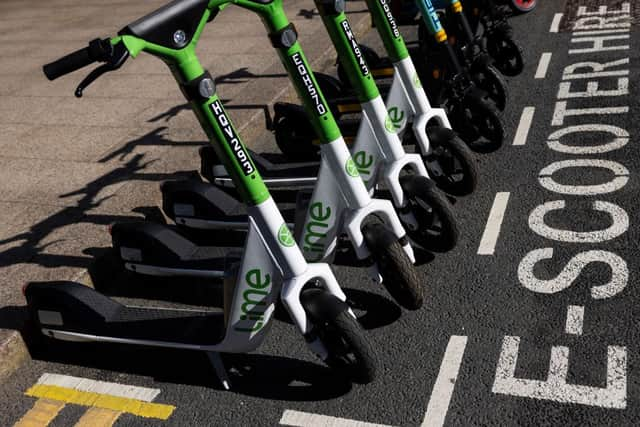Explainer: What are the rules on e-scooters in London and where can I ride them?
and live on Freeview channel 276
Many Londoners have got used to narrowly avoiding e-scooters speeding past them on the pavement or in the street.
But while some people are rueing them as a potentially dangerous nuisance, others are hailing the vehilce as the future of micro-mobility.
Advertisement
Hide AdAdvertisement
Hide AdTransport for London announced an e-scooter rental trial in June, making it legal to ride the speedy vehicle for the first time in the city, and their prevalence on the streets of London is growing.
Here is all you need to know about riding e-scooters in the Capital.
What is the legal status of e-scooters in London?
It is perfectly legal to buy, own, or sell e-scooters in the UK – as noted by shops such as Onboards in Angel, Islington, and Personal Electric Transport in Hackney.
However, privately-owned e-scooters currently fall under the ‘powered transporters’ rules, which state that it is illegal to ride them on a public road “without complying with a number of legal requirements, which potential users will find very difficult.”
Advertisement
Hide AdAdvertisement
Hide AdPrivately owned e-scooters can only be used “on private land with the permission of the land owner”.
Those using personal e-scooters on public roads and pathways face potential penalties which could range from “fines and penalty points to disqualification from driving”.
Additionally people using them under the influence of drink or drugs could face imprisonment.
What is the trial rental scheme from TFL?
As of June 2021, Transport for London has been trialling a hire service for electric scooters in various London boroughs for a year.
Advertisement
Hide AdAdvertisement
Hide AdThis is currently the only legal way to ride e-scooters in public places in London and requires that users stay within the boroughs taking part in the trial scheme.
The boroughs where e-scooters are currently allowed are: the City of London, Ealing, Hammersmith & Fulham, Kensington & Chelsea, Lambeth, Richmond Upon Thames, Southwark, and Tower Hamlets (including Canary Wharf).


How successful is the scheme so far?
The trial currently has 1,200 scooters on the road, with more than 85,000 trips taken so far, and just two “serious injuries reported” according to TfL.
Helen Sharp, TfL’s e-scooter trial lead, said: “Safety continues to be our top priority for the trial and we continue to work with the e-scooter operators, London Councils and the boroughs to ensure rigorous standards are being met.”
Advertisement
Hide AdAdvertisement
Hide AdHowever, there has been a recent bump in the road for the trial as Royal Parks – which looks after numerous green spaces in London including Hyde Park, Richmond Park and Primrose Hill – recently made announced it would not be trialling e-scooters in any of its parks.
How do I take part in the trial scheme?
The trial is being run by TfL, which is allowing a number of private companies to operate their services.
Users can download the companies’ apps on their smartphone to use the vehicles.
Do I need a driving licence?
Currently, users are required to be over 18 and hold a provisional or full driving licence.
All trial providers will ask you to verify this.
Advertisement
Hide AdAdvertisement
Hide AdHow much do they cost to rent?
Trips are priced between £3.25 and £3.40 for a 15-minute ride – with the current average ride being 23 minutes.
What other safety measures are in place?
New users are asked to take part in a mandatory in-app training before their first ride, to get to grips with the basics.
The trial announcement also states that London safety standards “go further than those set out at a national level”.
This includes a lower maximum speed of 12.5mph , compared to 15mph nationally, front and rear lights which are always on and automatic stoppages in designated “no go” areas.
Wearing a helmet is recommended but is not mandatory.
Comment Guidelines
National World encourages reader discussion on our stories. User feedback, insights and back-and-forth exchanges add a rich layer of context to reporting. Please review our Community Guidelines before commenting.